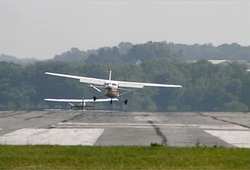Aero-Tips!
A good pilot is always learning -- how many times have you heard
this old standard throughout your flying career? There is no truer
statement in all of flying (well, with the possible exception of
"there are no old, bold pilots.")

Aero-News has called upon the expertise of Thomas P. Turner,
master CFI and all-around-good-guy, to bring our readers -- and us
-- daily tips to improve our skills as aviators. Some of them, you
may have heard before... but for each of us, there will also be
something we might never have considered before, or something that
didn't "stick" the way it should have the first time we memorized
it for the practical test.
Look for our daily Aero-Tips segments, coming each day to you
through the Aero-News Network.
Aero-Tips 08.09.06
Here's one that's sure to generate some reader mail... and
that's my hope, that it gets people thinking. Question for the day:
are touch-and-go landings truly instructional, and are they worth
the risk?
A training standard
 Touch-and-goes, a landing with just
enough time on the ground to reconfigure and take back off, are a
rite of flight instruction. All too often, though, touch-and-goes
result in loss of control and a runway excursion; "T&Gs" are a
frequent contributing factor to inadvertent landing gear retraction
on the runway and even seem to play a part in gear-up landings.
Given that T&Gs appear so frequently in accident write-ups, why
is it we still train the maneuver, and should we re-think the
T&G maneuver?
Touch-and-goes, a landing with just
enough time on the ground to reconfigure and take back off, are a
rite of flight instruction. All too often, though, touch-and-goes
result in loss of control and a runway excursion; "T&Gs" are a
frequent contributing factor to inadvertent landing gear retraction
on the runway and even seem to play a part in gear-up landings.
Given that T&Gs appear so frequently in accident write-ups, why
is it we still train the maneuver, and should we re-think the
T&G maneuver?
Training benefit
There are two benefits of T&Gs:
- Time. T&Gs provide more landing practice
per hour. A student flying T&Gs might log seven or eight
takeoffs and landings in an hour, while full-stops might permit
only four or five.
- Money. More landings per hour means less money
for the same landing experience. Some airports (especially outside
the US) encourage T&Gs by charging fees for each full-stop
landing.
However, flying a T&G the pilot must, in a very short
time...
- Quickly and correctly manage power controls.
In piston airplanes this may be up to four inputs: throttle,
propeller, mixture and carburetor heat. If the pilot does not set
mixture to rich before landing, or the airport is at a high density
altitude, this may require attention at a time of rapid change.
Turbine pilots may have to direct attention to engine indicators to
avoid overtemps or overtorques.
- Reconfigure the airplane, including flap and, if
equipped, cowl flap position. Here's where the danger of
accidentally pulling up the landing gear is manifested again and
again in accident reports.
- Retrim the airplane. Many aircraft are trimmed
radically nose up, away from a safe takeoff trim position if the
pilot uses trim for landing. Failure to reset the trim is known to
have resulted in fatal post-crash stalls.
- Maintain directional control throughout this
very high-workload maneuver.
- Review and evaluate the landing process if any
training benefit is to be realized.
Are T&Gs worth it?
I contend that more valuable instruction comes from landing to a
full stop, reconfiguring the airplane using the postlanding
checklist, taxiing back to the runway threshold and making another
takeoff. This provides "scenario-based training" that encompasses
the entire landing sequence, reinforces the use of a pretakeoff
checklist insure proper configuration before each flight, and gives
the time to critique and discuss the individual landing so learning
is not lost in a jumble of T&Gs reviewed as a group after the
lesson is complete.
Note: T&G practice does teach the
advanced student and certificated pilot a technique for an
emergency go-around should he/she detect a runway hazard after
touching down -- such as an animal or another airplane on the
runway, or the inability to meet a "land and hold short"
requirement. So T&Gs do have a limited training benefit as an
emergency maneuver.
Aero-tip of the day: Ask yourself if you're
really getting the full learning benefit of practice by doing
touch-and-goes, and if the T&G maneuver is worth the known
risks.
 ANN's Daily Aero-Linx (04.17.24)
ANN's Daily Aero-Linx (04.17.24) ANN's Daily Aero-Term (04.17.24): Jamming
ANN's Daily Aero-Term (04.17.24): Jamming ANN's Daily Aero-Linx (04.18.24)
ANN's Daily Aero-Linx (04.18.24) Aero-News: Quote of the Day (04.18.24)
Aero-News: Quote of the Day (04.18.24) ANN's Daily Aero-Term (04.18.24): Hold-In-Lieu Of Procedure Turn
ANN's Daily Aero-Term (04.18.24): Hold-In-Lieu Of Procedure Turn




